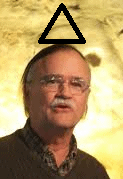This was a first for me. The cardinal directions are labeled N, E, S & O. The west edge of the grant shown on the map is the Rio Grande.
http://www.rplsfaq.com/images/GALAN NORTH ARROE.jpg

Kent McMillan, post: 182254, member: 3 wrote: > Why do you like complicated confusing boundaries that are ambiguous and problematic, but a simple north arrow?
Well, the whole point of the map is to facilitate an economical and lucid explanation of some boundary situation that may well be problematic. Adding doo-dahs to the map that carry zero information other than some very basic fact such as the North direction on the map are essentially cartographic graffiti. One has to ask why the person who drew the map wanted to add such distractions. In other words: "Why such gaudy patter?"
I would say because drafting was at one time an art. As an artist I would think you would appreciate that. The art lends an air of individuality that I rather enjoy.
Jim you do realize that Kent was arguing debating this 4 YEARS AGO?!
Andy: The "o" on your north arrow is obviously the work of the instrumentman: "Your other east, @#*^@ !"
Andy Nold, post: 372105, member: 7 wrote: The cardinal directions are labeled N, E, S & O
I would have guessed that to be common in areas with Spanish land history.
BajaOR, post: 372120, member: 9139 wrote: Andy: The "o" on your north arrow is obviously the work of the instrumentman: "Your other east, @#*^@ !"
That's exactly correct as West in Spanish is o-este, which I imagine loosely translates to "other east". 😉
imaudigger, post: 372116, member: 7286 wrote: Jim you do realize that Kent was
arguingdebating this 4 YEARS AGO?



